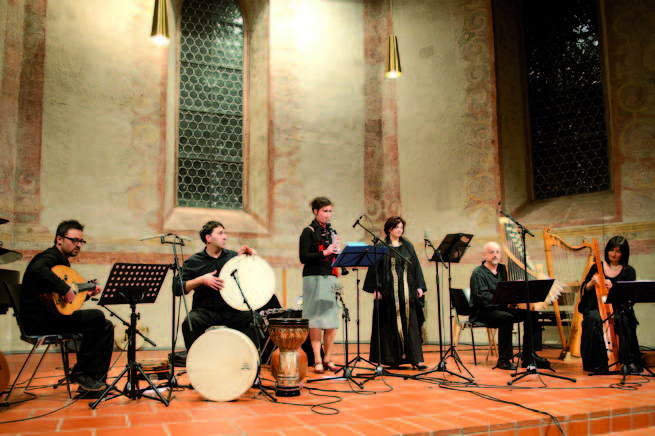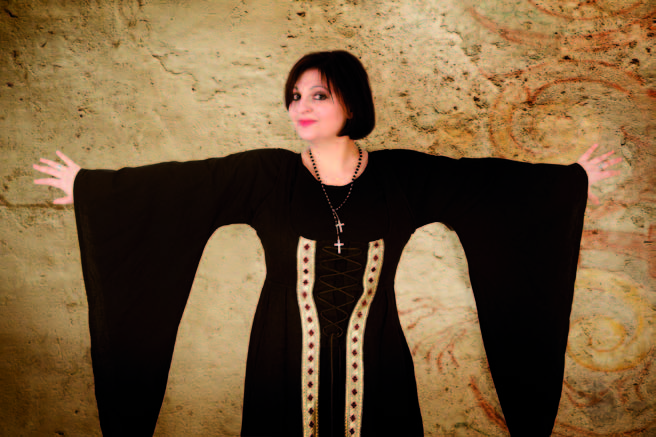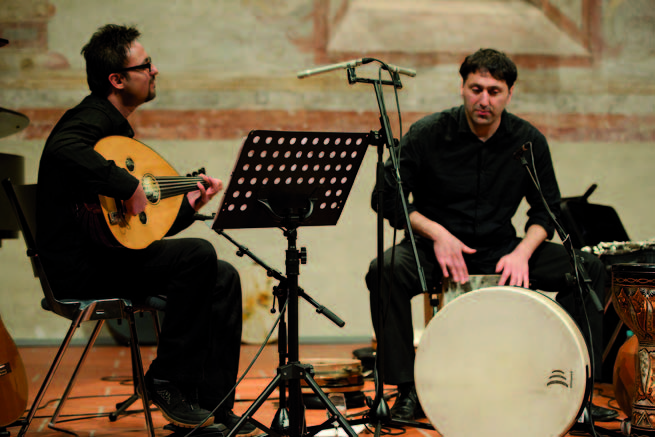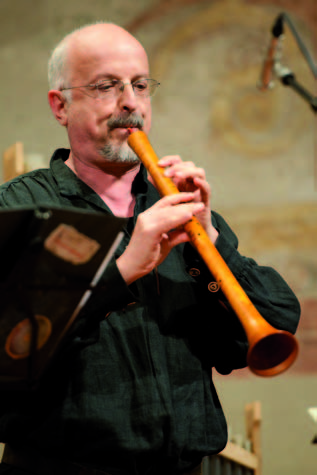
Christophorus CHR 77375
2013

Christophorus CHR 77375
2013
1. Tres Morillas [7:40] Spain 16th c.
2. Ghaetta [5:02] Istanpitta, Italy 14th c.
3. Ben póde Santa María [4:37] Cantiga de Santa Maria, Spain 13th c.
CSM 189
4. Quen bõa dona querrá [5:12] Cantiga de Santa Maria, Spain 13th c.
CSM 160
5. B’tayhi-M’saddar [4:59] Traditional Arab-Andalusian
6. Como poden per sas culpas [5:26] Cantiga de Santa Maria, Spain 13th c.
CSM 166
7. Ostinato I [5:52] Composition: Annette MAYE
8. Passacalli della vita [5:54] Italy 1657
9. Si dolce è’l tormento [6:06] Claudio MONTEVERDI (1567-1643)
10. Djamila [5:44] Composition: Murat COŞKUN
11. Ay! linda amiga [4:15] Spain 16th (?) c.
12. Por que llorax blanca niña [5:17] Sephardic, 16th c.
13. Cuando el Rey Nimrod [6:13] Sephardic, 16th c.
Nach vielen Jahren musikalischen Schaffens
heben sich die Grenzen zwischen „Eigenem“ und
„Fremdem“ fast völlig auf. Die Begegnung mit Musik aus
unterschiedlichsten Kulturen und rund 1000 Jahren Musikgeschichte, ein
offenes Ohr und ein ebensolches Herz prägen die Musikerinnen und
Musiker, die sich hier für das Projekt „oriental touch
– medieval music meets oriental Jazz“ zusammengetan haben.
Tres Morillas [1]
entführt bereits mit den ersten Klängen der orientalischen
Laute nach Spanien in die kulturell stark verwobene Welt der
„katholischen Könige“ Isabella I. und Ferdinand II.
Während deren Herrschaft im frühen 16. Jahrhundert wurde die
Liedersammlung Cancionero Musical de Palacio
zusammengetragen, aus der dieses Lied eines anonymen Verfassers stammt.
Wie bei einigen anderen Stücken daraus, ist auch der Inhalt dieses
Liedes rätselhaft und kann in seiner Bedeutung mehrschichtig
verstanden werden. „In drei Maurinnen habe ich mich verliebt
– in Axa, Fatima und Marien...“ Diese drei Frauennamen
können auch sinnbildlich die Zugehörigkeit zu drei
verschiedenen Religionen darstellen, die einst im spanischen Reich zu
finden waren. Am Ende des Liedes sagen diese drei: „Christen sind
wir nun, die einst Maurinnen waren“. Möglicherweise ist dies
als melancholischer Hinweis auf die Zwangschristianisierung
während der „Reconquista“ zu verstehen, die von den
„Reyes Catolicos“ blutig vorangetrieben wurde.
Regina Kabis
After
many years of musical production, the boundaries between “native” and
“foreign” almost completely cancel each other out. Encounters with music
from the most varied cultures and about 1000 years of music history, an
open ear and heart, characterise the musicians who have come together
here for the project “oriental touch – medieval music meets oriental
jazz”.
Already with the first sounds of the oriental lute, Tres Morillas
[1] carries us off to Spain, into the culturally involved world of the
“Catholic Kings” Isabella I and Ferdinand II. The song collection Cancionero Musical de Palacio
was compiled during their reign in the early 16th century, from which
this song by an anonymous composer is taken. As with several other
pieces from this collection, the content of this song is puzzling and
can be interpreted on several levels. “I have fallen in love with three
Moors – Axa, Fatima and Maria...” These three women’s names can also be
taken to symbolise allegiance to the three different religions that
could once be found in the Spanish Empire. At the end of the song, these
three say: “We are now Christians, we who were once Moors”. This can
possibly be understood as a melancholy reference to the forced
conversions to Christianity during the “Reconquista” with which the
“Reyes Catolicos” pressed ahead sobloodily.
Regina Kabis

Spielleyt · FisFüz
Regina Kabis — soprano
Annette Maye — clarinet, bass clarinet
Gürkan Balkan — oud, guitar
Jutta Haaf — historical harp, portativ
Murat Coşkun — percussion
Albrecht Haaf — flutes, shawm, portativ, piano
www.freiburger-spielleyt.de
www.fisfuez.de
Executive producer: Joachim Berenbold
Recording: recorded live on 13 & 14 March 2013 at Martinskirche Müllheim (Germany)
Recording Producer & digital editing: Rainer Lenz, acoustic media, Freiburg
Layout: Joachim Berenbold · Cover photo: Olivia Biarnés
Artist photos: Ellen Schmauss (www.ellenschmauss.de)
Translations: David Babcock (English) · Sylvie Coquillat (français)
℗ + © 2013 note 1 music gmbh, Heidelberg, Germany
English liner notes

Das Fremde und das Eigene
Zu hören sind zwei renommierte Ensembles, die eines verbindet: das
Spiel mit dem Ausnahmekünstler Murat Coskun, der mit seinen
vielfältigen Perkussionsinstrumenten die Welt bereist und sich mit
seinem virtuosen und feinfühligen Spiel in bemerkenswert vielen
musikalischen Genres bewegt.
Das preisgekrönte Trio FisFüz
spielt weltweit seit 1995 „oriental Jazz“ – und das
vom Feinsten! Die Klarinettistin und Musikwissenschaftlerin Annette
Maye beschäftigt sich vor allem mit der Verbindung von Jazz und
Klezmer und beeindruckt mit ihrer schier nicht enden wollenden
Improvisationslust. So ist es eine Freude, mit ihr die Bühne zu
teilen! Gürkan Balkan – Spross einer Istanbuler
Musikerfamilie – ist bei FizFüz der Dritte im Bunde. Er
studierte die klassische Oud, sowie Gitarre, Klavier und Komposition
und trägt mit seinem melancholischsüßen Sound einen
Großteil zum „oriental touch“ dieser Produktion bei.
Die Freiburger Spielleyt
– bei diesem Projekt in kleinerer Besetzung – bilden als
„Ensemble für frühe Musik“ den Gegenpol. Mit
ihrer sinnlichen und klaren Stimme nun seit über zwanzig Jahren
die Sängerin der Spielleyt, interpretiert Regina Kabis die Lieder
dieses Konzertprogrammes mal sehnsüchtig, mal lebensfroh, so wie
sie das Leben geschrieben hat und noch immer schreibt.
Albrecht Haaf, der Gründer der Spielleyt,
der auch für dieses Projekt zahlreiche Ideen für die
Arrangements im Gepäck hatte, und seine Frau Jutta Haaf, an den
beiden Harfen, kleiden die im Laufe vieler Jahre zusammengetragene
Musik aus dem 13. bis 17. Jahrhundert in ein neues Gewand. Sowohl das
Organetto, eine mittelalterliche Orgel, die auf dem Schoß
gespielt wird, als auch das Jazzpiano kommen zum Einsatz.
Die beiden Ensembles FisFüz und die Freiburger Spielleyt
trafen sich, um „Fremdes“ und „Eigenes“ zu
verbinden. Herausgekommen ist eine lebendige und mitreißende
Musik, die geografische und kulturelle Grenzen sprengt und zeitliche
Epochen verschmelzen lässt. Scheinbar weit voneinander entfernte
Stile wie die modale Musik des Mittelalters, galante Lieder des
italienischen Frühbarocks und gegenwärtiger Jazz mit
orientalischem Einschlag finden hier zueinander als gäbe es keine
Distanzen.
Eine musikalische Kommunikation zwischen historischer Harfe und
orientalischer Laute, Schalmei und Klarinette, zahlreichen
Rahmentrommeln sowie anderen Perkussionsinstrumenten, dazu eine
geschmeidige Stimme, die längst vergangene Geschichten neu
erzählt: Musik als Ausdruck für Freude und Leid, Hingabe,
Lebenslust, Gottesnähe und einer Sehnsucht, die die Welt umspannt.

Die Ghaetta [2], eine
anonyme Istanpitta aus einer oberitalienischen Handschrift des 14.
Jahrhunderts, in der verschiedene Teile (puncti) immer wieder vom
gleichen Refrain gefolgt werden, hat Annette Maye dazu angeregt, einen
neuen Teil für die Klarinette zu schreiben und in die
mittelalterliche Notenvorlage einzufügen – ganz im Sinne der
Musizierpraxis der mittelalterlichen Spielleute!
Ben Póde Santa María [3] aus den Cantigas de Santa Maria,
einer Sammlung von Marienliedern des 13. Jahrhunderts aus Galizien, hat
uns vor allem wegen seines spannenden Inhaltes inspiriert: Hier wird
von einem Pilger berichtet, der einen Drachen getötet hat, aber
von dessen Gift, mit dem er in Berührung kam, erkrankt war. Durch
Gebete, Hilferufe und festen Glauben an die Güte der Mutter Gottes
wurde er wieder gesund. Unsere Interpretation mit viel Perkussion und
wildem Klarinettensound ist stark vom Drachen inspiriert.
Quen bõa dona querrá [4] ist, wie wir finden, eines der sphärischsten Lieder aus den Cantigas.
König Alfons X., genannt „der Weise“, ließ
dieses mit zahlreichen Bildern ausgestattete Liederbuch erstellen. An
seinem Hofe lebten Moslems, Juden und Christen friedlich miteinander,
standen in regem Austausch und waren auch gemeinsam als Musiker
tätig. Allein dieses fruchtbare Miteinander prädestiniert
diese Lieder für unser Projekt!
„B‘tayhi“ und „M‘saddar“ sind
Bezeichnungen musikalischer Parameter in der arabischandalusischen
Musik. Für B’tayhi-M’saddar
[5] ist daher der Klang der arabischen Laute (Oud) natürlich
ebenso stilgerecht wie der Klang der Handtrommeln, während
mittelalterliche Schalmei und die Klarinette wiederum den Klang des
Abendlandes in dieses energetische Stück einbringen.
Como poden per sas culpas
[6] ist ebenfalls den Cantigas de Santa Maria entnommen und erinnert
uns heute wegen seiner interessanten Rhythmik fast schon an Flamenco.
Es wird von Mittelalterensembles häufig und gerne interpretiert
und erscheint in unserer Fassung, bereichert durch phantasievolle
Improvisationen, in neuem Gewand. Auch in diesem Text geht es wieder um
einen armen Sünder, der durch Opferbereitschaft und Glauben durch
die Jungfrau Maria von einer Krankheit geheilt wird. Es war die
Blütezeit der Marienverehrung...
 Das Instrumentalstück Ostinato I
[7] stammt aus der Feder von Annette Maye und ist der
süditalienischen Tarantella nachempfunden. Geprägt von der
auf italienischen Traditionen beruhenden Musik des Jazzklarinettisten
Gianluigi Trovesi, lässt die Komponistin spielerisch Elemente
uralter Folklore mit jazzigen Improvisationen verschmelzen. Getragen
vom kontinuierlichen Bassklarinetten-Ostinato, hält sich die
Tarantella zunächst unter einer gemächlich
dahinfließenden Melodie verborgen. Ihr wahrer Charakter entpuppt
sich erst nach und nach – immer schneller werdend, vom treibenden
Puls des Tamburello angefacht, dringt sie schließlich bis in
wilde improvisatorische Gefilde und somit ins Hier und Jetzt vor.
Das Instrumentalstück Ostinato I
[7] stammt aus der Feder von Annette Maye und ist der
süditalienischen Tarantella nachempfunden. Geprägt von der
auf italienischen Traditionen beruhenden Musik des Jazzklarinettisten
Gianluigi Trovesi, lässt die Komponistin spielerisch Elemente
uralter Folklore mit jazzigen Improvisationen verschmelzen. Getragen
vom kontinuierlichen Bassklarinetten-Ostinato, hält sich die
Tarantella zunächst unter einer gemächlich
dahinfließenden Melodie verborgen. Ihr wahrer Charakter entpuppt
sich erst nach und nach – immer schneller werdend, vom treibenden
Puls des Tamburello angefacht, dringt sie schließlich bis in
wilde improvisatorische Gefilde und somit ins Hier und Jetzt vor.
Süss, sanft und melancholisch hingegen ist die Musik aus Italien.
Zwei Kompositionen aus der beginnenden Barockzeit lassen unsere
Harfenistin zur barocken Harfe greifen, die wiederum mit dem
Jazzklavier konfrontiert wird.
Nicht nur, aber auch wegen seines fast schon makaber wirkenden Refrains
„bisogna morire“ – „es muss gestorben
werden“ – spielen wir die Passacaglia della vita
[8] leidenschaftlich gern. Denn: „was wahr ist, muss wahr
bleiben“, und so hat dieses Totentanzlied einen fast schon
fröhlichen Charakter, der unterm Strich eines am meisten
widerspiegelt: die Lebensfreude! „Ob Du reich bist, oder arm
– am Ende spielt es doch keine Rolle. Du kannst nichts mitnehmen,
darum: lebe! Tanze, singe, esse, trinke, sei fröhlich!“
Mit Si dolce è‘l tormento
[9] haben wir uns erlaubt, ein wunderschönes Kleinod aus Claudio
Monteverdis Feder zu interpretieren und sind
selbst vor dem Einsatz des modernen
Flügels nicht zurückgeschreckt. 1624 zum ersten Mal im Druck
erschienen, ist dieses barocke Lied von unglaublicher Schönheit,
Schlichtheit und Strahlkraft. Wohl wissend, dass es auch ohne unser
Zutun ein großer musikalischer Schatz ist, haben wir viel Freude
daran, es liebevoll und zart zu umspielen.
Djamila [10] ist ein Instrumentalstück, welches Murat Coskun ursprünglich für das Trio FisFüz geschrieben hatte. Inspiriert wurde der Perkussionist durch die Hauptfigur aus Aitmatov´s Buch Dshamilja,
in dem die Liebe und das Leben einer lebensfrohen und selbstbewussten
jungen Frau beschrieben wird. Ein Buch, welches von Louis Aragon 1959
als „die schönste Liebesgeschichte der Welt
bezeichnet“ wurde…
Ay! linda amiga [11]
ist einfach mal ein Liebeslied, das mit wenig Worten alles sagt:
„Es gibt keine Liebe ohne Schmerz und keinen Schmerz der
größer ist, als der der Liebe.“ Wer unter uns kann
kein Lied davon singen...?
Mit Por que llorax blanca niña und Cuando el Rey Nimrod
interpretieren wir zwei Lieder, die vor allem unsere in Klezmer-Musik
versierte Klarinettistin Annette in musikalisch heimatliche Gefilde
führen. Die im Original sehr langen Lieder spielen wir in
gekürzter Form. Sie sind jüdischen Ursprungs, mündlich
tradierte Werke der Sefarden – der spanischen Juden –, die
im Laufe der Geschichte so häufig auf Wanderschaft gehen mussten.
Ihre Sprache, hier Ladino, und ihre Musik haben sie immer wieder
mitgenommen. Wir wissen nicht, wie alt diese Lieder wirklich sind, aber
sie werden sicher auch unsere Gegenwart überdauern, wie sie schon
so vieles überdauert haben.
Por que llorax blanca niña
[12] erzählt von einem hartherzigen Mann, der seine Frau mit ihren
kleinen Kindern zurücklässt. „Wenn das Geld nicht
reicht, verkauf die Weinberge. Bin ich nach sieben Jahren nicht
zurück, dann heirate einen anderen“. Die Mutter aber steht
zu der jungen Frau und verflucht ihren eigenen Sohn. Im Traum fliegen
sie am Ende gemeinsam zu den Sternen... Eine phantasievolle Geschichte
zwischen Wunsch und Wirklichkeit.
Cuando el Rey Nimrod
[13] ist ein Lied der Freude und des Jubels über die Geburt des
Vaters Abraham, der als Vater der drei großen Religionen
Judentum, Islam und Christentum gilt. Mit diesem Hinweis auf die
gemeinsame Herkunft und die enge Verwandtschaft zwischen den Menschen
beschließen wir unsere gemeinsame musikalische Reise, die wir
Ausführenden sehr genossen haben!
Two renowned ensembles can be heard here, united by one
thing: playing with the exceptional artist Murat Coskun, who travels the
world with his wide variety of percussion instruments and is active in a
remarkable number of genres with his virtuosic and sensitive playing.
The prize-winning trio FisFüz
has been playing “oriental jazz” around the world since 1995 – and of
the finest kind! The clarinettist and musicologist Annette Maye is
especially occupied with the connection between jazz and Klezmer; her
virtually unlimited zest for improvisation is what impresses listeners.
This makes it a joy to share the stage with her! Gürkan Balkan –
offspring of a family of musicians from Istanbul – is the third member
of FizFüz. He studied classical oud, as well as guitar, pianoand
composition, and contributes a great deal to the “oriental touch” of
this production with his melancholic-sweet sound.
The Freiburg Spielleyt
– in a small ensemble for this project – form the counterpart as an
“ensemble for Early Music”. Regina Kabis, the singer of the Spielleyt
for over twenty years, interprets the songs of this concert programme
with her sensuous and clear voice. These are songs that could have been
written by life itself – sometimes with longing, at other times full of
zest for living.
Albrecht Haaf, the founder of the Spielleyt who also contributed numerous ideas for the arrangements
for
this project, and his wife Jutta Haaf, both playing harps, have
provided this music from the 13th to the 17th century with new clothing
over the course of many years. Both the organetto, a medieval organ
played on one’s lap, and the jazz piano are heard here.
The two ensembles FisFüz and the Freiburg Spielleyt
came together in order to connect the “foreign” with the “native”. The
result is lively and thrilling music that goes beyond geographical and
cultural borders and blends together different epochs. Styles that
appear to be far removed from each other, such as the modal music of the
Middle Ages, gallant songs of the early Italian baroque and present-day
jazz with an oriental touch meet here as if there were no distances
between them.
A musical communication between the historical harp
and oriental lute, the shawm and the clarinet, numerous frame drums and
other percussion instruments, plus a supple voice that tells stories
long past: this is music as the expression of joy and suffering,
devotion, joy of living, nearness to God and a longing that spans the
world.

The Ghaetta
[2], an anonymous Istanpitta from an Upper Italian fourteenth-century
manuscript, in which different parts (puncti) are always followed by the
same refrain, motivated Annette Maye to write a new clarinet part for
and to incorporate it into the medieval score – completely in the spirit
of the musical practice of medieval musicians!
Ben Póde Santa María [3] from the Cantigas de Santa Maria,
a collection of songs to the Virgin Mary from thirteenth-century
Galicia, inspired us especially because of its exciting content. It
tells of a pilgrim who slew a dragon but became ill from having come
into direct contact with its poison. Through prayers, cries for help and
firm faith in the Virgin Mary, he became healthy again. Our
interpretation with a great deal of percussion and wild clarinet playing
is strongly inspired by the dragon.
Quen bõa dona querrá [4] is, in our opinion,
one of the most ethereal songs from the Cantigas.
King Alphonse X, called “The Wise”, had this song book made with
numerous illustrations. Moslems, Jews and Christians lived peacefully
together at his court, enjoyed much exchange with each other and were
active together as musicians. This fruitful coexistence alone
predestines these songs from the Cantigas de Santa Maria for our project!
“B’tayhi”
and “M’saddar” are designations of musical parameters in
Arabian-Andalusian music. Thus the sound of the Arabian lute (oud) is,
naturally, as true to the original style for B’tayhi-M’saddar
[5] as the sound of the hand drums, whereas the medieval shawm and the
clarinet bring the sound of the Occident into this energetic piece.
Como poden per sas culpas
[6] is also taken from the Cantigas de Santa Maria and, today, almost
reminds us of Flamenco because of its interesting rhythmic language.
Medieval ensembles enjoy interpreting it and do so frequently; in our
version it appears in new clothing, enriched by imaginative
improvisations. This text, too, is about a poor sinner who is healed
from an illness through the Virgin Mary thanks to his faith and
willingness to make sacrifices. This was the heyday of the veneration of
the Virgin Mary...
 The instrumental piece Ostinato I
[7] was composed by Annette Maye and modelled on the South Italian
tarantella. Influenced by the music of the jazz clarinettist Gianluigi
Trovesi, in turn based on Italian traditions, the composer allows
playful elements of ancient folklore to blend with jazzy improvisations.
Carried by a continuous bass-clarinet ostinato, the tarantella is at
first hidden beneath a leisurely flowing melody. Its true character is
only gradually revealed – constantly accelerating, kindled by the
driving pulse of the tamburello, it finally advances into a wildly
improvisatory realm, and thus into the here and now.
The instrumental piece Ostinato I
[7] was composed by Annette Maye and modelled on the South Italian
tarantella. Influenced by the music of the jazz clarinettist Gianluigi
Trovesi, in turn based on Italian traditions, the composer allows
playful elements of ancient folklore to blend with jazzy improvisations.
Carried by a continuous bass-clarinet ostinato, the tarantella is at
first hidden beneath a leisurely flowing melody. Its true character is
only gradually revealed – constantly accelerating, kindled by the
driving pulse of the tamburello, it finally advances into a wildly
improvisatory realm, and thus into the here and now.
The music of
Italy, on the other hand, is sweet, gentle and melancholy. Two
compositions from the early baroque period led our harpist to the
baroque harp, which then finds itself confronted with the jazz piano.
We are passionately fond of playing the Passacaglia della vita [8], because of the almost
macabre
effect of its refrain “bisogna morire“ – “someone has to die” – but not
only for that reason. For “what is true must remain so”, and this song
of a dance macabre has an almost cheerful character which, after all,
reflects one thing most of all: the joy of living! “Whether you are rich
or poor – this makes no difference in the end. You can’t take anything
with you, so: live! Dance, sing, eat, drink, be of good cheer!”
With Si dolce è‘l tormento [9]
we have taken the liberty of interpreting a beautiful idyll from
the
pen of Claudio Monteverdi and were not even afraid of using the modern
grand piano. Published for the first time in 1624, this baroque song is
of an unbelievable beauty, simplicity and radiance. Knowing full well
that it is also a great musical treasure without our intervention, we
very much enjoy playing with it in a lovingly gentle manner.
Djamila [10] is an instrumental piece that Murat Coskun
had originally written for the trio Fis-Füz.
The percussionist was inspired by the main character from Aitmatov´s book Dshamilja, in
which
the love and the life of a vital and self-confidant young woman are
described. A book that Louis Aragon in 1959 called “the world’s most
beautiful love story...”
Ay! linda amiga
[11] is simply a love song that says it all in just a few words: “There
is no love without pain, and no pain greater than love.” Who amongst us
does not have a thing or two to say about that...?
With Por que llorax blanca niña and Cuando el Rey Nimrod,
we interpret two songs in which it is our clarinettist Annette, in
particular - well-versed as she is in Klezmer music - who leads us into
the musical realm of homeland. These are songs of Sephardic Jews - the
Jews of Spain who so often had to migrate during the course of history -
handed down by the oral tradition. They always took their language,
Ladino in this case, and their music with them. We do not know how old
these songs are, but they will surely survive the present day as well,
just as they have already survived so much else.
Por que llorax blanca niña [12] tells of a hard-hearted man who leaves behind his wife with
her
small children. “If there’s not enough money, sell the vineyards. If
I’m not back in seven years, marry someone else.” His mother, however,
stands by the young woman and curses her own son. In the end they fly to
the stars together... An imaginative story between desire and reality.
Cuando el Rey Nimrod
[13] is a song of joy and jubilation over the birth of Abraham, who is
considered the father of the three great religions Judaism, Islam and
Christianity. With this reference to their common origins and the close
relationship between human beings, we now conclude our shared musical
journey - which we, the interpreters, have so greatly enjoyed!
